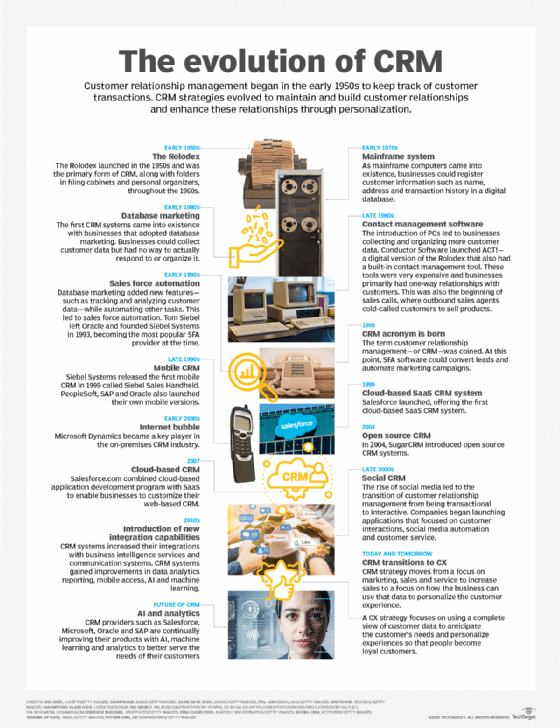The history and evolution of CRM
Early CRM systems only stored basic contact information. Yet, they have evolved into complex AI platforms that automate various sales, marketing and customer service tasks.

CRM has evolved from paper-based contact management tools, like the Rolodex and file cabinets, to complex digital systems that integrate every aspect of an organization.
Modern CRM systems use advanced technologies, like cloud computing, AI and automation, to help organizations build meaningful relationships with customers and personalize experiences across marketing, sales and customer service interactions.
The evolution of CRM includes the following five stages:
- 1950s-1970s: The beginnings of CRM.
- 1980s-1990s: The rise of digital CRM.
- 2000s: The era of cloud and mobile CRM.
- 2010s: Integration and personalization.
- 2020s: AI and accelerated digital transformation.
1950s-1970s: The beginnings of CRM
CRM began as a simple way to record transactions and track customer information. In the 1950s, organizations used tools like the Rolodex -- a physical device that stored index cards on a spindle -- and filing cabinets to organize customer data. Businesses relied heavily on these paper-based systems to maintain customer records, which were often limited to basic details like names, addresses and purchase histories.
By the 1970s, the emergence of mainframe computers had transformed data storage. Organizations began to transition from paper records to digital databases, which let them store customer information more efficiently. These early systems introduced the concept of centralized data management and laid the groundwork for modern CRM systems. However, early mainframe computers lacked the ability to analyze or act on the data.
1980s-1990s: The rise of digital CRM
Database marketing emerged in the 1980s as organizations began to collect customer data on a larger scale. Database marketing systems were more advanced than earlier mainframe computers of the 1970s, but they still lacked tools to organize and respond to data effectively.
However, the introduction of personal computers in the late 1980s brought significant advancements to CRM, including contact management software like ACT!, which digitized the Rolodex and added basic organizational features.
Then, in the 1990s, the emergence of sales force automation (SFA) introduced automation capabilities to CRM systems. SFA tasks, such as lead tracking and campaign management, helped organizations analyze customer data and improve sales processes.
In 1993, Tom Siebel founded Siebel Systems, which became the leading SFA software vendor. By 1995, industry experts coined the term "customer relationship management," which established CRM as a critical practice for organizations worldwide.
2000s: The era of cloud and mobile CRM
The 2000s brought significant changes to CRM, with the rise of cloud computing and mobile technology. For instance, Salesforce launched the first cloud-based SaaS CRM system in 1999, which paved the way for widespread cloud adoption in the 2000s and beyond.
Microsoft Dynamics 365 entered the market as a key player in on-premises CRM systems for organizations that preferred local installations. Then, in 2004, SugarCRM introduced open source systems to offer organizations more customizable and cost-effective options.
By 2007, Salesforce combined its cloud-based CRM system with application development capabilities, so organizations could tailor their systems to fit their specific needs.
The late 2000s also saw the rise of social media and social CRM. Organizations began to use CRM tools to interact with customers on social platforms and automate social media campaigns to enhance marketing, sales and customer service.
2010s: Integration and personalization
The 2010s saw significant innovation in CRM systems, with a focus on integration and personalization. CRM platforms began to offer business intelligence tools, advanced data analytics and machine learning capabilities. These integrations gave organizations deeper insights into customer behavior to improve marketing and customer service.
Additionally, mobile access became a standard feature in the 2010s. It let sales and service teams access CRM tools from anywhere with an internet connection. Also, AI-powered features, such as predictive analytics and automated workflows, made CRM systems more efficient and effective.
By 2016, CRM strategies shifted toward a more holistic CX approach and began to incorporate personalization throughout the entire customer journey. Organizations used CRM systems to anticipate customers' needs, personalize experiences and encourage long-term loyalty. This transition introduced CRM as a central component of CX strategy.
2020s: AI and accelerated digital transformation
In 2020, the COVID-19 pandemic led to social distancing practices and a massive uptick in remote work and e-commerce. This situation forced organizations to implement remote operations and online customer engagement within weeks or months. Many CRM vendors updated their offerings to include virtual communication tools and e-commerce support to meet these new demands.
Then, in 2023, generative AI (GenAI) emerged. CRM vendors raced to launch GenAI features, like intelligent chatbots, automated content creation and advanced AI analytics tools. These tools enhanced customer interactions and streamlined operations.
By late 2024, major CRM vendors like Salesforce, Microsoft and HubSpot had introduced agentic AI capabilities. Unlike GenAI, which focuses mostly on content creation and requires a human to prompt it, agentic AI operates autonomously to analyze data, predict outcomes and take actions without human input. These systems can automate complex tasks and support proactive customer engagement.
Key takeaways
CRM systems evolved from simple contact management tools like the Rolodex and ACT! to advanced software platforms that unite sales, marketing and customer service departments. These systems use cloud technology and AI to help organizations improve customer relationships and increase sales. As organizations continue to adopt AI-powered tools, CRM systems will likely remain a key component of CX.
Editor's note: This article was originally published in 2020 and updated to reflect changes in CRM technology.
Tim Murphy is site editor for Informa TechTarget's SearchCustomerExperience and SearchContentManagement sites.